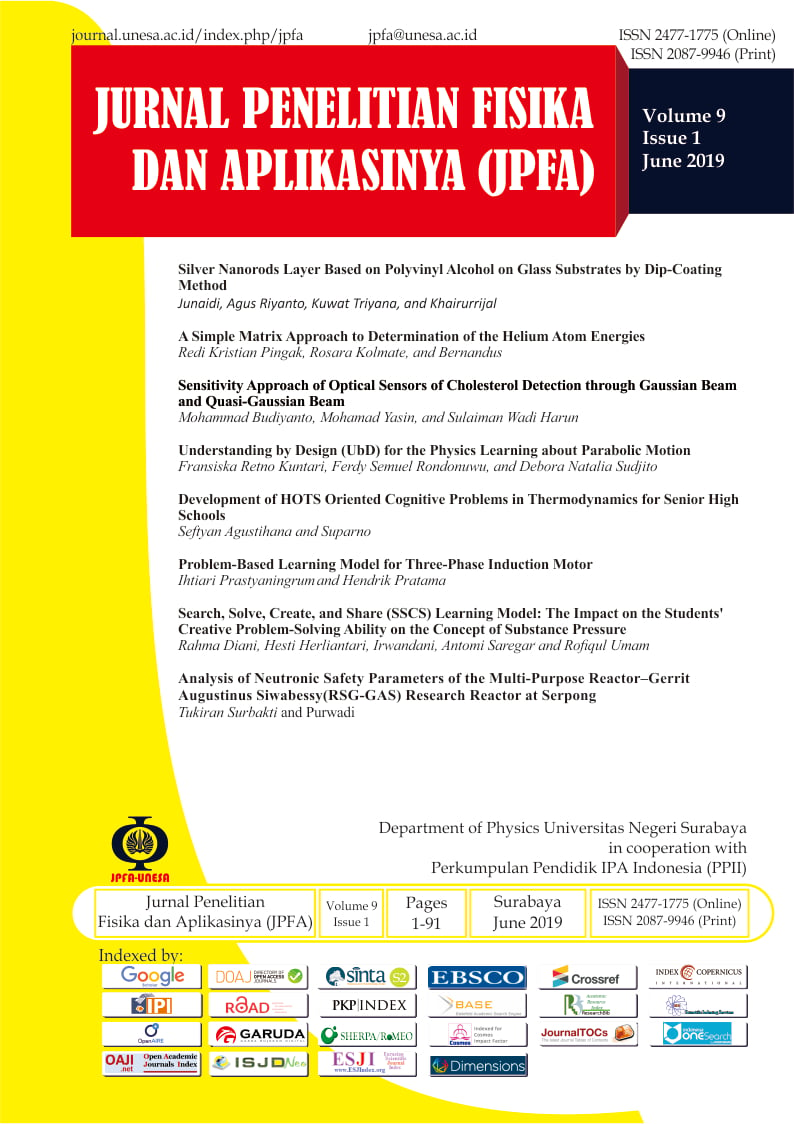Understanding by Design (UbD) for the Physics Learning about Parabolic Motion
DOI:
https://doi.org/10.26740/jpfa.v9n1.p32-43Keywords:
Learning Design, Qualitative Research, Understanding by Design, Parabolic MotionAbstract
In general, in preparing the lesson, teachers determine some components namely learning objectives, procedures, and evaluation and assessment instruments. Several problems in Physics learning on Parabolic Motion indicate possible flaws from the three components in designing the lesson. Understanding by Design (UbD) is applied as one of the alternative strategies to improve the lesson quality by considering the learning objectives, procedures, and evaluation by reversing the design, namely proposing the objectives first, evaluations as the second, and lesson steps as the last step. This is a qualitative research intended to construct an alternative design of Physics learning on Parabolic Motion using UbD. The initial Physics learning design was reviewed and analyzed by experts and revised until the final design. Understanding by Design (UbD) could be used as an alternative design construction as it helps teachers to relate the three main components, namely learning objectives, evaluations, and steps so it eased the students understand the materials comprehensively and obtain maximum score. Despite the development of current materials needs more improvement, Understanding by Design (UbD) can applied for many materials.References
Nurdin S. Aspek Aplikasi Konsep Sains dalam Evaluasi Pembelajaran IPA di MI. Jurnal Pionir. 2013; 1(1): 115-130. Available from: https://jurnal.arraniry.ac.id/index.php/Pionir/article/view/160/141.
Sanjaya W. Perencanaan dan Desain Sistem Pembelajaran. Jakarta: Kencana; 2015.
Noviandini D, Sunarno W, and Cari. Remediasi Miskonsepsi Kinematika dengan Umpan Balik Cepat Menggunakan Simulasi
Komputer dan Demonstrasi. Inkuiri. 2014; 1-14. DOI: https://doi.org/10.20961/inkuiri.v3i01.9702.
Lila K. Pengembangan Tes Diagnostik Fisika Materi Gerak Parabola untuk Siswa Kelas XI di Kota Pontianak. Jurnal Pendidikan dan
Pembelajaran. 2017; 6(9): 1-8. Available from: http://jurnal.untan.ac.id/index.php/jpdpb/article/view/21854.
Corvo AF. Utilizing The National Research Councils (NRC) Conceptual Framework for The Next Generation Science Standards
(NGSS): A Self Study in My Science, Engineeringm and Mathematics Classroom. Doctoral Dissertation. Unpublished. New York: Columbia University; 2014. Available from: https://academiccommons.columbia.edu/doi/10.7916/D8RV0W3K/download.
Molina W. Teachers Views of Backwards Planning in a Suburban Elementary School in Hawaii. Doctoral Dissertation. Unpublished. Minessota: Walden University; 2013.
Anderson AR. Implementing Literature Circles: An Experimental Study in an English Language Learners Classroom. Doctoral Dissertation. Unpublished. Minneapolis: Capella University; 2012.
Schoellhorn L. œBringing History to Life Exploring the Historic Cemetery as a Primary Classroom Resource. Master Thesis. Unpublished. Missouri: Webster University; 2012.
Takacs JA. Using Formative Assessment in Professional Learning Communities to Advance Teaching and Learning. Doctoral Dissertation. Unpublished. Minessota: Walden University; 2010.
Yurtseven N and Altun S. Understanding by Design (UbD) in EFL Teaching Teachers Professional Development and Students Achievment. Educational Sciences: Theory and Practice. 2017; 17(2): 437-461. Website. DOI: https://doi.org/10.12738/estp.2017.2.0226.
Almaseid TF. The Impact of Using Understanding by Design (UbD) Model on 8th-Grade Students Achievement in Science. European Scientific Journal. 2017; 13(4): 301-315. DOI: http://dx.doi.org/10.19044/esj.2017.v13n4p301.
Fox BE and Doherty JJ. Design to Learn, Learn to Design: Using Backward Design for Information Literacy Instruction. Communications in Information Literacy. 2012; 5(2): 144-155. DOI: https://doi.org/10.15760/comminfolit.2012.5.2.109.
McTighe J and Thomas RS. Backward Design for Forward Action. Educational Leadership: Using Data to Improve Student Achievement. 2003; 60(5): 52-55. Available from: http://www.ascd.org/publications/educational-leadership/feb03/vol60/num05/Backward-Design-for-Forward-Action.aspx.
Sgro SD and Freeman SA. Teaching Critical Thinking Using Understanding by Design. Proceeding of 2008 ASEE Annual
Conference and Exposition. Department of Agricultural and Biosystems Engineering, Iowa State University. 2008; 224. Available from: https://lib.dr.iastate.edu/abe_eng_conf/224.
Yusuf AM. Metode Penelitian Kuantitatif, Kualitatif dan Penelitian Gabungan. Jakarta: Prenada Media; 2016.
Pertiwi S, Sudjito DN, and Rondonuwu FS. Perancangan Pembelajaran Fisika tentang Rangkaian Seri dan Paralel untuk Resistor Menggunakan Understanding by Design (UbD). Jurnal Sains dan Edukasi Sains. 2019; 2(1): 1-7. DOI: https://doi.org/10.24246/juses.v2i1p1-7.
Setyanto JR, Sudjito DN, and Rondonuwu FS. The Use of Understanding by Design in Designing the Physics Lesson Plan About Newtons Second Law. Journal of Science and Science Education. 2018; 2(2): 69-80. Available from: https://ejournal.uksw.edu/josse/article/view/1936.
Wijaya RC, Damris M, and Kamid K. Pengembangan Media Pembelajaran Fisika Projectile Launcher sebagai Alat Praktikum
Fisika pada Materi Gerak Parabola Fisika Kelas XI IPA. Edu-Sains: Jurnal Pendidikan Matematika dan Ilmu Pengetahuan Alam.
2014; 3(2): 46-56. Available from: https://onlinejournal.unja.ac.id/edusains/article/view/1895.
Indah DS. Pengembangan Alat Peraga Sederhana Gerak Parabola untuk Memotivasi Siswa pada Pembelajaran Fisika Pokok
Bahasan Gerak Parabola. Inovasi Pendidikan Fisika. 2014; 3(2): 89-94. Available from: https://jurnalmahasiswa.unesa.ac.id/index.php/inovasi-pendidikanfisika/article/view/8075.
Karanggulimu L, Sudjito DN, and Noviandini D. Desain Modul Praktikum Mandiri Tentang Gerak Parabola Menggunakan Simulasi PhET Projectile Motion. Proceeding of Seminar Nasional
Pendidikan, Sains dan Teknologi. Faculty of Mathematics and Natural Sciences, Universitas Muhamadiyah Semarang. 2017; 216-226. Available from: https://jurnal.unimus.ac.id/index.php/psn12012010/article/view/3062.
Suwarto. Pengembangan Tes Diagnostik dalam Pembelajaran. Yogyakarta: Pustaka Belajar; 2013.
Berg EV. Miskonsepsi Fisika dan Remediasi. Salatiga: Universitas Kristen Satya Wacana; 1991.
Karim S and Saepuzaman D. Analisis Kesulitan Mahasiswa Calon Guru Fisika dalam Memahami Konsep Gerak Parabola. Proceeding of Seminar Nasional Fisika (SNF) 2016. Department of Physics, Universitas Negeri Jakarta. 2016; 1-5. Available from: http://journal.unj.ac.id/unj/index.php/prosidingsnf/article/view/4031.
Yarso AA, Sahala S, and Arsyid SB. Remediasi Miskonsepsi Siswa Menggunakan Model Kooperatif Tipe Kancing Gemerincing pada Gerak Parabola di SMA. Jurnal Pendidikan dan Pembelajaran. 2014; 3(6): 6124. Available from: http://jurnal.untan.ac.id/index.php/jpdpb/article/view/6124.
Suparno P. Miskonsepsi dan Perubahan Konsep dalam Pendidikan Fisika. Jakarta: Grasindo; 2013.
Downloads
Published
How to Cite
Issue
Section
License
Author(s) who wish to publish with this journal should agree to the following terms:
- Author(s) retain copyright and grant the journal right of first publication with the work simultaneously licensed under a Creative Commons Attribution-Non Commercial 4.0 License (CC BY-NC) that allows others to share the work with an acknowledgement of the work's authorship and initial publication in this journal for noncommercial purposes.
- Author(s) are able to enter into separate, additional contractual arrangements for the non-exclusive distribution of the journal's published version of the work (e.g., post it to an institutional repository or publish it in a book), with an acknowledgement of its initial publication in this journal.
The publisher publish and distribute the Article with the copyright notice to the JPFA with the article license CC-BY-NC 4.0.
 Abstract views: 10899
,
Abstract views: 10899
, PDF Downloads: 16966
PDF Downloads: 16966









